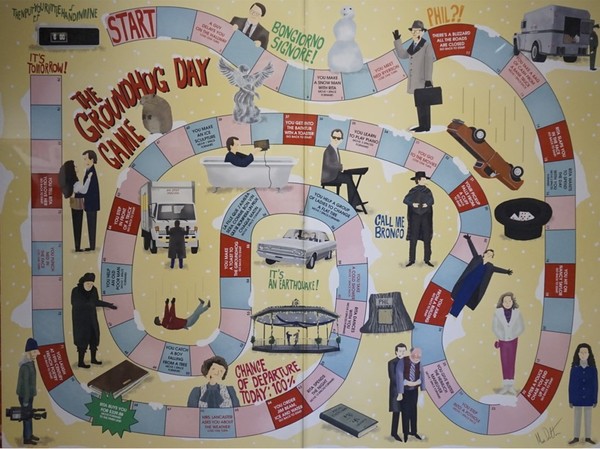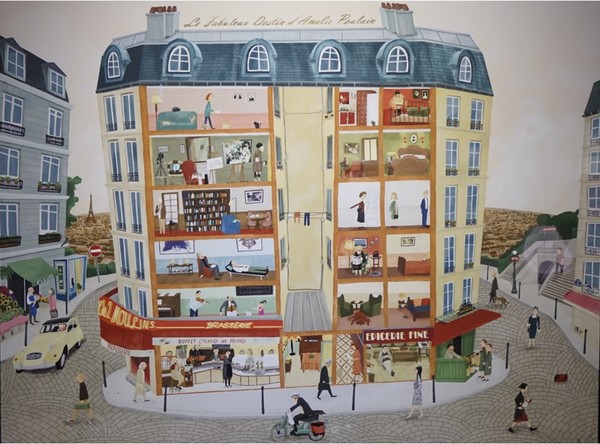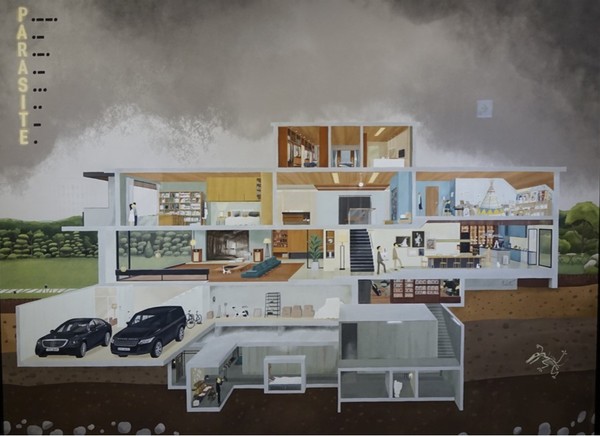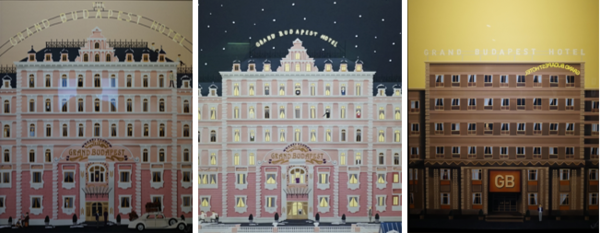Are you a Cinephile? If you like movies, you must visit this exhibition! Every step of yours on the exhibition will be a series of delight and excitement, enough to stimulate your fan spirit. <Max Dalton, Moments in Film> presents the best scenes and lines of the masterpieces of the past half century of film history, reinterpreted with detailed observation and imagination by illustrator Max Dalton. This exhibition shows about 220 pieces of Max Dalton’s works, and his new works created only for this exhibition are unveiled for the first time. You can also see various works related to the movie <The Grand Budapest Hotel> and its director Wes Anderson. Welcome to the fantastic art world of Max Dalton!
Galactical Imagination

In this painting, there stands a blue phone box with the phrase “Police Box” with a fairytale-like green background. What is the meaning of “OUTSIDE, TARDIS IS NICE TOO. IT IS A LITTLE SMALLER THAN THE INSIDE, THOUGH.” written above? The blue phone box is called “TARDIS[1],” a time machine from the British TV series <Doctor Who>. It tells the episodes of the Doctor, an alien who looks like a human and is owner of the TARDIS, traveling around the Galaxy with his human companion. And this phrase means that the inside of the TARDIS, which travels beyond time and space, is larger than the outside world. This work is an homage to the fairy tale book “Henri’s Walk to Paris,” there is the TARDIS instead of Henri’s house. Max Dalton has changed the original phrase corresponding to the context of <Doctor Who>. It gives a glimpse of Max Dalton’s deep understanding of the original work and his reinterpretation skills using a combination of various works. By the way, if you are a fan of sci-fi films, you may fall in love with the first section of the exhibition, ‘Galactical Imagination.’ Here you can see a homage to various sci-fi movies, such as <Star Wars>, as well as sci-fi TV series, such as <Star Trek> in illustrations.
Moments in Beloved Film
Board Games

Why is this movie drawn as a board game? The movie <Groundhog Day> is a “time loop” film in the fantasy comedy genre, in which the main character is trapped in a specific time zone that infinitely repeats itself. Max Dalton has represented this unique setting of the movie in a board game illustration. Each space of the board game contains what happens to the main character Phil Connors, who gets trapped in the Groundhog Day. Since the red squares say, “GO BACK TO START,” you should go back to the beginning when you throw a dice and step on them. And at the destination, it says “IT’S TOMORROW!” As you see, this work reflects the movie’s setting of a time loop very well.

This work is also a shape of a board game, but has a different meaning from the previous one. It features <The Lord of the Rings> trilogy on a single canvas. “Starting from Frodo’s hometown Shire, the game takes one on the journey to Mordor in destroying the ring.” Viewers can play the game by moving forward or backward following notes like “Gollum attacks you to take the ring but falls from a cliff. Move forward two squares.” What Max Dalton tried to convey with this board game figure was that the journey is as important as the destination. Like this, Max Dalton does not simply reproduce the film as it is but reinterprets it in his own style, creating a new work with his own messages.
Cross-section

What should be noted in this work is that the house where Amelie stays is cut in cross-section like a doll’s house. Because of this, viewers can see Amelie’s neighbors and the inside of their houses. In many of Max Dalton’s works, he uses painting techniques that reconstruct space by comprehensively placing different time-bound characters on one screen. This allows us to grasp the movie multidimensionally and spatially, not in a straight flow of time like when watching the movie.

Max Dalton’s new work for this exhibition, <Parasite> also uses the same technique. The picture shows the cross-section of the Park’s mansion. And the main theme of the movie “hierarchy,” is expressed with divided layers of ground with different colors. As Max Dalton structures the narrative by repeatedly watching the movies, the symbols in this movie are represented detailed in this work. If you’ve watched the movie <Parasite>, try to focus on the details while looking at this work.
The Grand Budapest Hotel and Nostalgia
The Hotel in Different Time and Colors

Max Dalton is a big fan of director Wes Anderson, and is an illustrator of the “Wes Anderson Collection” artbook series. He said he loves the way the director looks at the world and deals with what was forgotten by the times. <The Grand Budapest Hotel> takes the largest proportion in the third section. Max Dalton valued the color, and he painted the hotel in three versions. He drew day and night of the hotel in its most grand prime, 1932, and the hotel when it lost its reputation and was almost falling apart, 1968. These works show that we can receive a completely different impression depending on what time the painting is drawn and on the color.
You can also see some details on these pictures. In all pictures, there are characters standing behind the windows. In the day version, there is a car of Madame D with lots of baggage, and a shoeshine boy, both appear in the beginning of the movie. In the night version, there you can see members of Society of the Crossed Keys holding hotel phones on their ears, who play a significant role in the middle of the movie. If you look closely, you will realize that Kovacs holds his cat in the day version, but Jopling holds Kovacs’ cat in night version. If you’ve watched the movie, you will know what it means. In the last version, there are only three people; an author, elderly Zero, and M. Jean. These pictures reflect the details of the film very well, and you can appreciate them by comparing them to each other.
Characters in Full-length Portraits

Max Dalton has created 18 pieces of full-length portraits of the characters from the movie for this exhibition. In many of his works, he adopts full-length portraits because he wants to emphasize not only the main character but also all the characters in the same density. Therefore, a maid Clotilde and a baker Herr Mendl, can get an attention as much as M. Gustave. These full-length portraits are drawn subtly differently from each other by reflecting the individuality of each character, such as facial expressions, posture, and costumes. Here, Zero glances to his left. That's because his beloved Agatha is there. Max Dalton even directed the location of each work himself, which indicates how much sincerity he had in his work.
Max Dalton’s elaborate observation and creative imagination show his passion for the film, and every single piece of his work has his true heart. You might be unwilling to step aside because you want to capture every piece of his work and its details in your eyes. As if hide-and-seek, <Max Dalton, Moments in Film> makes your heart pound while walking around the exhibition. Max Dalton said, “There is no greater feeling than entering the world of someone that you admire so much and get to contribute to that world." Let’s dive into the moment of the film with Max Dalton’s fantastic imagination!
Dates: 2021.04.16~2021.07.11
Hours: 10:00~20:00 every day (The last entrance 19:00) closed on the last Monday of each month
Place: MY ART MUSEUM
Ticket Prices: Adults 15,000 won / Teenagers 12,000 won / Children 10,000 won / Toddlers (under 36 months)) free
Contact: 02-567-8878
[1] An acronym for ‘Time And Relative Dimension In Space’

